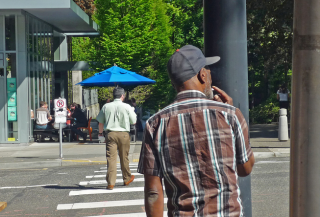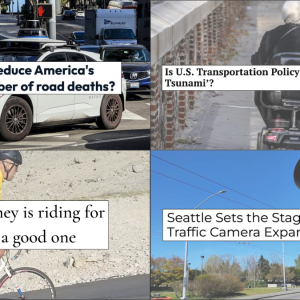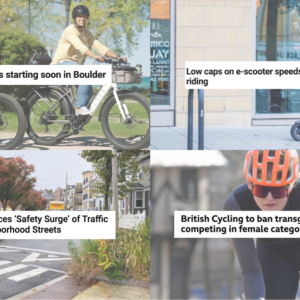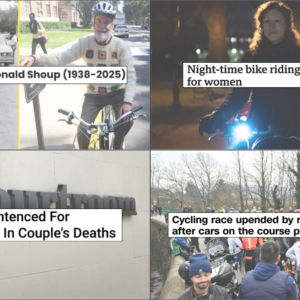Here are the bike links from around the Web that caught our eyes this week:
Race at the crosswalk: Twice as many Portlanders drive past a black person at a crosswalk than drive past a white person, new research found.
Bike theft petition: Bike-software maker Project 529 has launched a petition asking Craigslist and eBay to make it harder to fence stolen bikes by requiring serial numbers on all bike listings.
Firefighters vs. safety: Too many fire departments are “prioritizing fire truck access in a way that makes streets less safe for pedestrians and other users.” CityLab (the site formerly known as Atlantic Cities) thinks there must be a better way.
Bike fashion: Women’s fashion site XOVain has brought on a writer who’s focusing entirely on bike-fashion howtos.
Distracted biking: Wearing earbuds, talking on the phone or texting while biking makes you more likely to bike dangerously. Wearing a single earbud doesn’t affect behavior — but it does impair your ability to locate the direction a sound is coming from.
Advertisement
Bicycle socialism: Sweden’s second-largest city has an interesting solution for reducing auto traffic: they’re lending residents bikes for free.
Bikes as bivalves: One year in, the “most important” benefit of bike sharing in New York City is that they make the streets safer for everyone by calming traffic, “like bivalves helping to clean a polluted waterway.”
Building for biking: “The main difference between Boston and Jacksonville is not sidewalks, trails, ‘complete streets’ policies, or crosswalks” — it’s their real estate development patterns. It’s time for biking and walking advocates to focus on urbanism, writes BetterCities.net.
Thriving startup: U.K. children’s bike maker Islabikes, whose U.S. headquarters is in Portland, says it’s growing fast and planning to expand again.
Salem bridge: The City of Salem has “crafted a delicious double-bind” for its new highway bridge by piling possible neighborhood mitigation measures into a growth management grant that it might not get.
Reinventing parking: If your city is going to allow microapartments, then it’s got to be ready to change its social contract around auto parking, says David Friedlander.
Dirty air: Bike commuters inhale seven to nine times more benzene than a car driver on the same route.
Preventable deaths: The death of a boy who was holding his father’s hand in a New York crosswalk when a left-turning taxi smashed into them is a parable for our unsafe streets. (The driver will face no criminal charges.)
Cognitive dissonance: “Expressions of wonderment have been heard as to why the runners of the automobiles have not been arrested for sending their carriages along at so reckless a rate,” the New York Times wrote in May 1899.
If you come across a noteworthy bicycle story, send it in via email, Tweet @bikeportland, or whatever else and we’ll consider adding it to next Monday’s roundup.








Thanks for reading.
BikePortland has served this community with independent community journalism since 2005. We rely on subscriptions from readers like you to survive. Your financial support is vital in keeping this valuable resource alive and well.
Please subscribe today to strengthen and expand our work.
Want to know why the street calming on 28th will abruptly end when it crosses 1-84?
Portland Fire Department.
I live right near that Fred Meyer, and 28th going by there, which also has a children’s park, is a blind-corner death trap. I brought this up to the PBOT staffer at one of the open houses, and said how I hoped they would shorten crossing distances with bulb-outs and put in speed bumps to slow down cars. NOPE! Fire department has the road classified wrong. And I said, well, now it’s dangerous, cars are going to hit someone soon.
You know what the PBOT staffer told me? A business owner on that corner has already had his business run through by cars. Something like 8 TIMES.
Unfortunately there is a dialysis clinic right there, and according to the Fire Dep. for some reason, that means the ability of all cars and trucks to go speeding around the corners (including massive fire trucks) is more important than the ability of people to safely cross the street to buy groceries or walk their toddlers to the park.
Standard fire engine trucks are too big; width, weight but most critically length.
This is essentially the same “hole in the air” argument that trucking freight companies are able to use. As a Portland resident and urban futurist I love our urban density and all the car free sensible things we try to do.
As a reluctant truck driver I despise poor zoning and planning that jams new dense walkable neighborhoods directly in the same formerly big industrial zones were there is still some industry. Now I have to drive 70’+ of truck & trailer through a tight street where quite frankly it isn’t safe to even be.
With freight this is solved by offloading to smaller box trucks. Fire departments have married themselves to the idea of a single 100+ function “swiss army knife” truck; of course it’s too big.
Much as i don’t like the militarization of our police and EMS forces in this case they could stand to take a lesson. The pump truck can be a single function vehicle that is much smaller. Lots of fireman needed at the scene? Send them in an APC designed specifically for fire resistance. Need medical support? Send ambulances.
We don’t need to continue to authorize purchases of ½-¾ million dollar firetrucks that are sized to fight the fires of yesteryear on Dallas-Fort Worth’s mega highway streets. Fire departments need to adapt to the cities we are are living in not tying us back to the asphalt dreams of the early 19th century.
I found and helped a homeless guy who had been a victim of a hit and run on that corner a few weeks ago. He was on his bike and was on the ground. People just driving by….
Regarding serial numbers being required on Craigslist.
In principle, I like the idea of holding people accountable and applaud efforts to thwart thieves and fences, and return bikes to their owners. I am worried about unintended consequences though. This would mean that all sellers would be putting serial number information out on the web along with their general location and often pictures of the bike in question.
Does anyone else wonder if there isn’t potential for that information to be abused?
I would much prefer a blind system. The Serial number goes into a database and checks flags in the police reports and the registries and the verification comes out without the serial number information.
There’s also the assumption that all bikes have serial numbers. I have two generic Chinese frames and two custom American-made frames that don’t. I also have an online photo album where I’ve photographed all of my bikes, including the frame and fork serial numbers where applicable. I like to think it’s a good reference in case I ever need to get an insurance company involved. I never publish location information – not that it can’t easily be found – but I can’t think of any motivation for that serial number information to be abused. Then again, none of my bikes are really anything that valuable or special (to anyone but me).
I guess the only bad thing I can think of is that with a Serial number and a basic description anyone can file a police report on a stolen bike or enter it in the stolen bike registry. I don’t know why anyone would do that.
In general, it just bugs me, putting info out in public for everyone to see.
What would prevent someone from listing a fake serial number. The only way this scheme could be effective is if the prospective buyer checks the serial number prior to making the purchase, then double checks that the advertised serial number of the bike they just bought is accurate.
a highly knowledgeable purchaser would at least know whether the serial number was obviously fake. a reasonably knowledgeable thief would have to utilize the manufacturer’s patterns of numbering.
Free Bikes Please! I think Sweden has the right idea. Cities and states should work together to give bikes away. It would be cheaper than building new road capacity. The Seattle Hwy 99 Tunnel project, even at it’s originally budgeted cost, could pay for a $700 bike for every resident of the State.
I had to chuckle a little about the article with the title “Ped-bike advocates and Urbanists: Get together”. Ironically, in the comments section, the ‘urbanist’ author actually gives his contact information to a ped-bike advocate… ah, the self-fulfilling prophecy. 😉
interesting the OTREC study had the confederates stand at the curb without actually stepping into the street.
http://ppms.otrec.us/media/project_files/TRF_Crosswalkpaper_Final.pdf
in other words, they were waiting for courtesy rather than compliance with the law, which requires the motorist to yield only when the pedestrian actually steps into the street.
i would speculate outside the study conditions the situation may actually be worse, as whites may feel more entitled to step into the street.
Can you always tell when someone wants to cross? Sometimes people are too busy looking at their iPhones to even bother to look up. Show intent to cross or get away from the curb.
in this case, the decoys stood at the curb at a marked crosswalk midblock and attempted eye contact with motorists. they did not, however, step into the street, which would have triggered the legal obligation.
Regarding the earbud piece on cyclists: I will stop listening to music on my bike when all radios are banned from cars as well. Seriously, I can still hear the rubber on the pavement from my tires, so I can definitely still hear the rubber on pavement of an electric car (and my head is always on a swivel). I challenge any car driver, even with the radio off, to hear an approaching passenger car from their semi-soundproof isolation chambers better than I can on my bike (even with earbuds in).
you can do what I do and listen to a small battery pack speaker. It really doesn’t get loud enough that other riders can hear it unless they’re stopped next to me at a light. If they’re annoyed by 30 seconds of music, it’s 30 seconds of their life – otherwise it’s a 30 second spontaneous dance party and then off we go.
I googled for “most bass Bluetooth speaker” and you can hear me from a block away 🙂
Is there an IPX68/78 version of the Jambox?
Not an equal comparison.
Drivers use mirrors and not sound to determine they are being overtaken by other vehicles.
yikes.
if you are relying on the puttering of an approaching motorized couch to avoid a collision you are doing it very wrong.
Yeah, like I said, “head on a swivel” means I’m routinely checking over my shoulders. It’s a lot easier on a bike than in a car (even with mirrors).
You turn your head around EVERY TIME a car passes you? This is an apples and oranges comparison as stated above, but also because bikes are a lot more likely to get passed by cars than cars are to get passed by other cars.
It’s not about checking over my shoulder every time a car passes me – it’s about checking over my shoulder to know if there’s a car approaching long before it even gets there. On a greenway, for example, I’m checking behind me every so often. Like every block or half block. If there’s a car approaching, I’ll see it coming before it’s even in ear shot (with or without buds). On arterials, I don’t necessarily check behind me until I am going to make a traffic maneuver of some kind because I always assume there’s always a car approaching. Hearing it or not hearing it makes no difference.
FWIW, I’ve been doing an experiment for a few years now of not using buds at all on my commute in to work and listening to music on my way home with buds. It makes no difference in my awareness of the cars around me. I can respect people that don’t want earbuds in their ears because it makes them nervous – I even resisted it for a while – but it’s turned out to seriously not make a difference for me. The wind noise when going fast is louder than my music – it drowns out more sounds around me than the earbuds do.
saying that earbuds make you a dangerous cyclist is saying that deaf cyclists are dangerous…
just like hands-free cell phone laws say that amputees are dangerous drivers…
distracted people are distracted…
Deaf people are hearing impaired. So are hearing people sticking things in their ear, but unlike people that really are deaf, they think they can still sufficiently hear the outside world around them over the distraction of sound plugged directly into their ear, and wind noise.
Too often, as far as hearing ability beyond their earbuds and so on, I-plodders have barely the slightest clue, if that, of what’s going on around them. Whether they’re riding or jogging, often its possible to roll up to them, get ready to pass, call out to announce what’s happening, and they never respond as if they’re aware that someone else besides themselves is there.
People riding and driving responsibly seem to have little choice but to put up with this hazard imposed on them. In European countries that rely on ‘Strict Liability’ to proportion responsibility for covering consequences of collisions between people driving motor vehicles and vulnerable road users, I wonder if and how use of ear inserted entertainment devices for hearing people, may change the outcome of court decisions.
“…I can still hear the rubber on the pavement from my tires, so I can definitely still hear the rubber on pavement of an electric car…” John Lascurettes
When the rubber on pavement of an electric car’s, or any motor vehicle’s tires come as close to you as your bike’s tires are, sure you can hear them. Unfortunately for you and all road users, that’s not a worthwhile advance notice at all. With your ear buds in and your music playing, can you still consistently hear a car approaching from the rear, a distance of, let’s say, 30′ away? That would be a more realistic hearing advance notice for a someone riding a bike.
As I noted earlier, often it seems to be, that hearing people with ear buds and so on, stuck in their ears, are apparently not hearing traffic approaching from behind them, at all. They’re maybe zoned out on their music, or whatever. That’s not a safe practice, especially for vulnerable road users. You can make up all the funny pumped up analogies you want, but the bottom line, is that direct into the earl listening devices used by hearing people while riding bikes in traffic, increases these vulnerable road users’ vulnerability to motor vehicle traffic they may be riding amongst.
Correction: “direct into the ear”
The consequences to a car driver, of failing to hear an oncoming car, are likely lesser than the consequences to a bicycle rider, of failing to hear the same thing.
Yep, I just listen to a $10 transistor radio in a patch pocket on my backpack strap. Nothing in my ear to diminish the sound coming in, and since it’s a couple inches from my ear it’s at a volume that people nearby rarely hear it at all, certainly not if there’s any traffic around.
Thank you for thinking of others!
I admit I might not stop for a black man standing on the corner at night wearing a black coat, dark jeans and black shoes.
http://www.oregonlaws.org/ors/811.100
The NYT article from 1899 is awesome. We are not different creatures than those people. We’ve only come to expect and accept dizzyingly high speeds for things and have collectively chosen speed over livability. Hey… it’s progress right?
You might enjoy the post futurist manifesto http://www.generation-online.org/p/fp_bifo5.htm
Regarding…[bicyclists] as bivalves…does this mean we are the air filters/ lungs of the city, that is for every polluted breath we take in we help by exhaling cleaner air?!
I think there may be a better analogy out there (avoiding pollution vs polishing it)…as I hope that bike facilities are not some sneaky big industry plan at pollution abatement. ;-(
The tobacco and oil industries have assured us that carcinogens are an important part of a balanced diet.
If you can’t trust your corporate overlords who can you trust?
Or does it mean we are tasty when simmered in white wine and garlic, and dipped in drawn butter?
> Dirty air: Bike commuters inhale seven to nine times more benzene than a car driver on the same route.
Two solutions: 1) give us routes with 7-9 times less car traffic and 2) reduce the amount of toxics cars are allowed to emit (in a related note, I wonder how much longer Portlanders will put up with autos powered by combustion engines spewing air and noise pollution through the city).